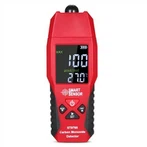Infrared thermometer working principle and characteristics
Blackbody radiation and principles of infrared temperature measurement
All objects with temperatures above absolute zero are constantly emitting infrared radiation energy into the surrounding space. The magnitude of infrared radiation energy of an object and its distribution by wavelength are closely related to its surface temperature. Therefore, by measuring the infrared energy emitted by an object itself, its surface temperature can be accurately determined, which is the objective basis for infrared radiation temperature measurement.
Blackbody radiation law: Blackbody is an idealized radiation body that absorbs radiation energy of all wavelengths without any reflection or transmission of energy. Its surface emissivity is 1, and the reflection coefficient of other substances is less than 1, which is called gray body. It should be pointed out that there is no real blackbody in nature, but in order to understand and obtain the distribution law of infrared radiation, it is necessary to choose a suitable model in theoretical research. This is the quantum oscillator model of body cavity radiation proposed by Planck, which derives the law of Planck blackbody radiation, that is, the spectral radiance of blackbody represented by wavelength. This is the starting point of all infrared radiation theories, hence the blackbody radiation law.
Characteristics of infrared thermometer
All objects with temperatures above absolute zero are constantly emitting infrared radiation energy into the surrounding space. The size of infrared radiation energy is closely related to its surface temperature in terms of wavelength distribution. Therefore, by measuring the infrared energy emitted by the object itself, its surface temperature can be accurately measured. Infrared thermometers can receive invisible infrared radiation energy emitted by various objects themselves. Infrared radiation is a part of the electromagnetic spectrum, with infrared located between visible light and radio waves. When the instrument measures temperature, the infrared radiation energy emitted by the object being measured is converted into an electrical signal on the detector through the optical system of the thermometer, and the surface temperature of the object being measured is displayed on the display part of the infrared thermometer.
Features of infrared thermometer: non-contact measurement, wide temperature measurement range, fast response speed, and high sensitivity. However, due to the influence of the emissivity of the measured object, it is almost impossible to measure the true temperature of the measured object, which is the surface temperature.






